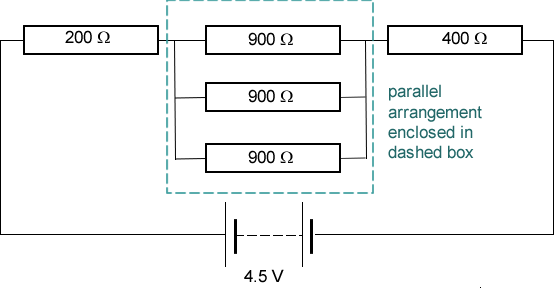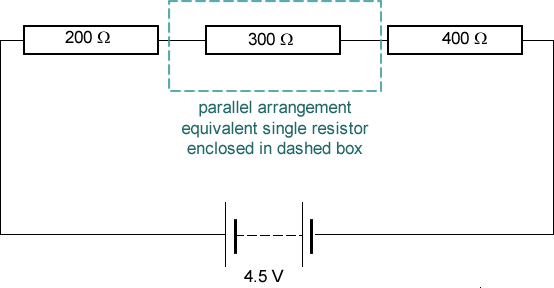|
The voltage drop across components in a circuit spreads out 'fairly' in accordance with resistance - the component with the biggest resistance gets the biggest share of total voltage drop applied, and vice versa.
How to work out voltage drops across components in a circuit.
Here is a simple circuit. You may be asked to calculate the potential difference across any one of the resistors.

You need to share out the voltage across the 'strands' of the circuit. In our example we need to simplify the parallel arrangement to a single resistor before we have a simple 'strand' arrangement to share the voltage across.
 Step 1 - simplify the circuit Step 1 - simplify the circuit
To do that, we have to replace the three 900Ω resistors in the parallel arrangement with a single one.
1/RTOT = 1/R1 +1/R2 + 1/R3
= 1/900 + 1/900 + 1/900 = 3/900
so, RTOT = 900/3 = 300Ω
We can now re-sketch the diagram

The 4.5 V will be shared out according to resistance value.
 Step 2 - work out the volts per ohm of the strand Step 2 - work out the volts per ohm of the strand
Add up the resistance of the strand:
200Ω + 300Ω + 400Ω = 900Ω
So, 4.5V is shared by 900Ω
Each ohm gets 4.5/900 = 0.005 V/Ω
 Step 3 - work out the voltage drop for each resistor Step 3 - work out the voltage drop for each resistor
200Ω resistor:
200 x 0.005 = 1.0V
300Ω resistor arrangement:
300 x 0.005 = 1.5V
400Ω resistor:
400 x 0.005 = 2.0V
 Step 4 - Check the voltage across the strand adds up to the P.D. supply Step 4 - Check the voltage across the strand adds up to the P.D. supply
1.0V + 1.5V + 2.0V = 4.5V - correct!
Simple Questions to Try
Q1. Three resistors are in series: 700Ω, 300Ω and 200Ω. Calculate the potential drop across the 700Ω resistor if a p.d. of 6.0 V is applied across the arrangement.
Q2.Three resistors are in series: 900Ω, 400Ω and 700Ω. Calculate the potential drop across the 700Ω resistor if a p.d. of 5.0 V is applied across the arrangement.
Q3. Two parallel sets of resistors are in series with a single 300Ω resistor. The first set is two 900Ω resistors in parallel with each other. The second is
a parallel arrangement of a 400Ω resistor and a 700Ω resistor. Calculate the potential drop across the 300Ω resistor if a PD of 10 volts is applied across the whole arrangement.
 Click here for the solutions Click here for the solutions
|




 Potential Division
Potential Division



 Step 1 - simplify the circuit
Step 1 - simplify the circuit

